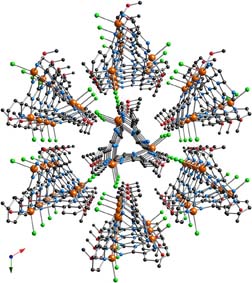
Researchers in the Universitat de València’s Molecular Science Institute (ICMol), located in Parc Científic, have found out the way to introduce gas molecules in non-porous materials, allowing them to act as molecular sensors. This finding enables the production of more versatile, precise sensors since, apart from the optical response for the molecules detection, the magnetic response is a capability which did not exist for this kind of crystalline materials up to now.
This work, published last Tuesday on the journal Nature Communications, is part of the doctoral thesis by Mónica Giménez Márquez. The thesis has been supervised by Guillermo Mínguez and Eugenio Coronado. The three of them are researchers at ICMol.
Intelligent materials respond to external stimulus like light, pressure, temperature or humidity in order to change its properties. These changements allow to use these materials as sensors. For example, in recent years some porous materials of metal-organic kind (MOF’s) have been designed. They change their properties as they host gas molecules in its pores. This feature has enabled these porous materials to be used as molecular sensors.
However, despite the magnetic materials are excellent intelligent materials, they have not been used to develop this application by now. The reason for this is that magnetism and porosity are two opposite properties: the first needs absence of pores to bring the metallic centres closer and thus trigger interaction; the second requires organic spacers to separate metallic centres and generate pores.
The authors of the work have proved that it is possible to modulate magnetic properties through a chemical stimulus in absence of pores, thus avoiding the problem of combining magnetism and gas absorption. The paper is published in the last number of Nature Communications.
Last update: 10 de may de 2012 08:43.
News release


















